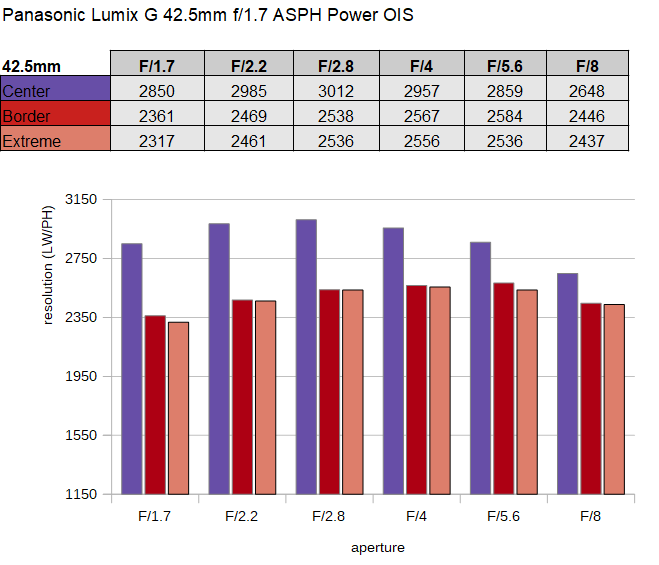|
Panasonic Lumix G 42.5mm f/1.7 ASPH Power OIS - Review / Test Report - Analysis |
|
Lens Reviews -
(Micro-)Four-Thirds
|
|
Page 2 of 3

Distortion
Image distortions are usually auto-corrected in the micro-four-thirds system. At just ~0.2% the remaining barrel distortion is basically unnoticeable. When looking behind the scenes (unaltered RAW files) the original characteristic is still quite decent with a barrel distortion of ~1.2% indicating that side-effects of the image correction will be minimal.
Vignetting
Auto-correction is also keeping vignetting at bay. The corrected light-falloff is very moderate (~0.5EV) at f/1.7 and it improves from there, of course.

MTF (resolution)
The resolution of the Panasonic Lumix G 42.5mm f/1.7 ASPH Power OIS is high with no major weakness. The center quality is excellent straight at f/1.7 and the outer image field is on a good to very good level. Stopping down results in a slight increase in quality until reaching a peak between f/2.8 and f/4 where the borders/corners are easily very good. Beyond diffraction is the limiting factor although you won't really notice a substantial decrease in quality until past f/8.
The field curvature is very low. The centering quality of the tested sample was very good.
Please note that the MTF results are not directly comparable across the different systems!
Below is a simplified summary of the formal findings. The chart shows line widths per picture height (LW/PH) which can be taken as a measure for sharpness.
If you want to know more about the MTF50 figures you may check out the corresponding Imatest Explanations

Chromatic Aberrations (CAs)
Lateral CAs are very well-controlled at 0.2px or less at the image borders. This isn't relevant anymore in real life.

Bokeh
The Panasonic Lumix G 42.5mm f/1.7 ASPH Power OIS can't excel regarding depth-of-field capabilities due to the relatively small sensor. However, it's still possible to achieve a decent amount of object separation so let's have a look at whether it can deliver a quality bokeh.
Out-of-focus highlights are nicely rendered as you can see below. The inner zone of the discs isn't perfectly clean but it comes close. There's also no outlining to speak of and the discs are perfectly circular even at f/2.8.
 The discs may be circular in the center but they ALWAYS deteriorate towards the image corners due to mechanical vignetting from the lens barrel. You may spot the usual "cat eyes" in the far image corners in the example below. That being said - the effect is comparatively moderate. Stopped down to f/2.2 the "good zone" broadens although the corner highlights look less natural at this setting. This trend continues at f/2.8.
The general rendering in the focus transition zones is silky in the image foreground (shown to the right below). The more interesting background (to the left) is, unfortunately, a little harsher at high contrast transitions.
The discs may be circular in the center but they ALWAYS deteriorate towards the image corners due to mechanical vignetting from the lens barrel. You may spot the usual "cat eyes" in the far image corners in the example below. That being said - the effect is comparatively moderate. Stopped down to f/2.2 the "good zone" broadens although the corner highlights look less natural at this setting. This trend continues at f/2.8.
The general rendering in the focus transition zones is silky in the image foreground (shown to the right below). The more interesting background (to the left) is, unfortunately, a little harsher at high contrast transitions.

|